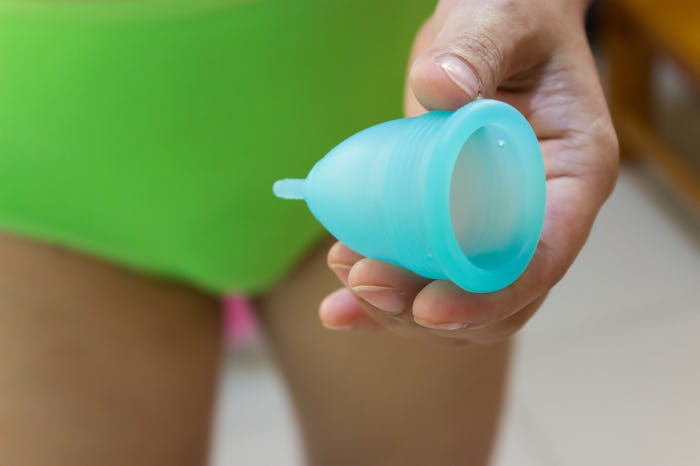Life

New Research Explores The Efficacy & Safety Of Menstrual Cups
When it comes to menstrual cycles, the truth is that everyone has their own preferences. With the invention of new hygienic products such as cups and hybrid underwear, some may be wondering whether they are effective or worth the investment. In particular, many have questioned whether menstrual cups are safe, and some new research released yesterday has shown that they're actually just as good as tampons and pads.
For those who have not used a menstrual cup, it is a plastic or silicone device that is flexible enough to be pinched closed and inserted into the vagina, where it will then open up again, and catch blood for a duration that's much longer than a pad or tampon, according to HealthLine. They are also often more eco-friendly and cost-effective; according to BuzzFeed News, the average menstrual cup can last you about 10 years, and can actually be inserted up to five hours longer than a tampon.
Beyond those benefits, the new research — published in Lancet Public Health, which analyzed a total of 43 studies and more than 3,300 people — showed that it is likewise as effective and safe as other products. Researchers found that menstrual cups did not pose any additional threat health-wise, and were just as effective at preventing leakage than disposable pads or tampons. "Our review indicates that menstrual cups are a safe option for menstruation management and are being used internationally," researchers wrote in the study.
This new research follows a 2018 study published in The journal Applied and Environmental Microbiology that found that, like traditional tampons, menstrual cups may pose a risk of TSS (toxic shock syndrome) if used improperly, according to Consumer Reports. And in the new report, according to NPR, researchers found there "were only five reported cases of TSS," but were not able to conclusively compare that statistic with other menstrual products "because the overall number of menstrual cup users is not known."
While more research is certainly needed, researchers are making progress. Professor Penelope Phillips-Howard, who led the study, told the Liverpool School of Tropical Medicine that until now, there was little comprehensive research on the quality and comparison of different sanitary products "despite the fact that 1.9 billion women globally are of menstruating age, spending on average 65 days a year dealing with menstrual blood flow, few good quality studies exist that compare sanitary products," Phillips-Howard said.
Additionally, according to News-Medical.Net, the paper's first author, Dr. Annemieke van Eijk, added that this new research can hopefully support "initiatives aimed at tackling period poverty, in both low- and high-income settings."
"It is really important that menstrual cups be considered as a potential option for women and girls everywhere," van Eijk said according to News-Medical.Net. "Cups can last up to 10 years and the data suggests that this means that period associated costs could be significantly reduced as well as being beneficial in terms of waste saving."
Menstrual cups are available in a range of prices. For example, one at Walmart is priced at $9.99 and one on Amazon can is available for $28.99.
The New York Times reported that another deterrent for women when it comes to the menstrual cup is that they are simply not as easy to use as a pad or tampon. "There is a learning curve. It takes some time and getting familiar with your body. And I think it’s very important for people who want to use the cup to be prepared for that," Phillips-Howard told The New York Times. There are, however, many tutorial videos available online as well as an explainer from Planned Parenthood.
More knowledge on the safety and efficacy of menstrual cups will hopefully bring more awareness to an alternative option that may work better for some. Because all women around the world should have access to sanitary, safe, and effective products to use throughout their periods.